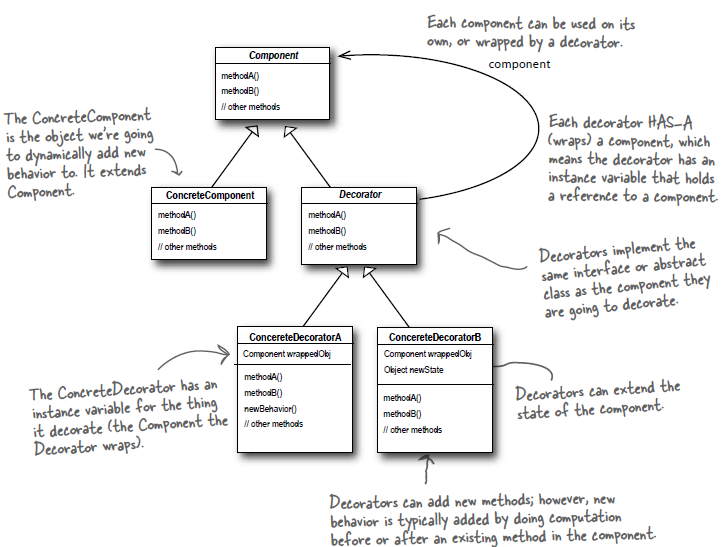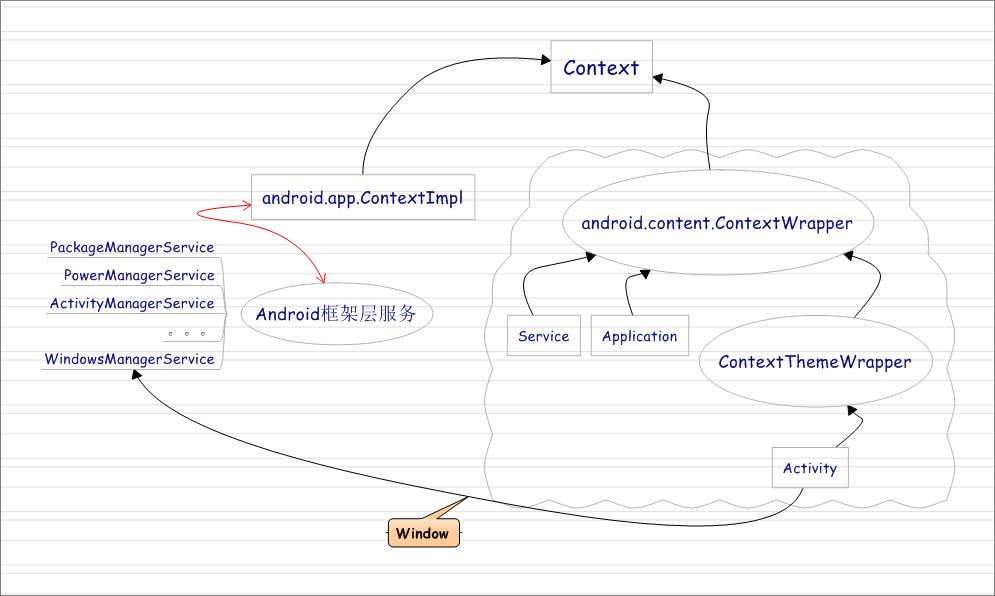主要内容:
一、装饰模式定义
| 装饰模式定义: |
| Attach additional responsibilities to an object dynamically keeping the same interface. Decoators provide a flexible alternative to subclassing for extending functionality. |
| 动态地给一个对象添加一些额外的职责。就增加功能来说,装饰模式相比生成子类更为灵活。 |

如上图所示(截取自《Head First Design Patterns》一书),主要包括四个部分:
1. Component抽象组件,是一个接口或者是抽象类,就是定义我们最核心的对象,也就是最原始的对象。(注:在装饰模式中,必然有一个最基本、最核心、最原始的接口或者抽象类充当Component抽象组件)
2. ConcreteComponent具体组件,是最核心、最原始、最基本的接口或抽象类的实现,我们需要装饰的就是它。
3. Decorator装饰角色, 一般是一个抽象类,实现接口或者抽象方法,它的属性里必然有一个private变量指向Component抽象组件。
4. 具体装饰角色,如上图中的ConcreteDecoratorA和ConcreteDecoratorB,我们要把我们最核心的、最原始的、最基本的东西装饰成其它东西。
二、装饰模式的优势
|
装饰类和被装饰类可以独立发展,而不会相互耦合。换句话说,Component类无须知道Decorator类,Decorator类是从外部来扩展Component类的功能,而Decorator也不用知道具体的组件。 |
| 装饰模式是继承关系的一个替代方案。我们看装饰类Decorator,不管装饰多少层,返回的对象还是Component,实现的还是is-a的关系。 |
| 装饰模式可以动态地扩展一个实现类的功能。 |
三、装饰模式在Android源码中的应用
在Android源码中,其中一个比较经典的使用到装饰模式的就是由Context抽象类扩展出的ContextWrapper的设计。继承结构如下图所示:

1. Context就是我们的抽象组件,它提供了应用运行的基本环境,是各组件和系统服务通信的桥梁,隐藏了应用与系统服务通信的细节,简化了上层应用的开发。所以Contex就是“装饰模式”里的Component。
2. Context类是个抽象类,android.app.ContextImpl派生实现了它的抽象接口。ContextImpl对象会与Android框架层的各个服务(包括组件管理服务、资源管理服务、安装管理服务等)建立远程连接,通过对Android进程间的通信机制(IPC)和这些服务进行通信。所以ContextImpl就是“装饰模式”里的ConcreteComponent。
3. 如果上层应用期望改变Context接口的实现,就需要使用android.content.ContextWrapper类,它派生自Context,其中具体实现都是通过组合的方式调用ContextImpl类的实例(在ContextWrapper中的private属性mBase)来完成的。这样的设计,使得ContextImpl与ContextWrapper子类的实现可以单独变化,彼此独立。所以可以看出ContextWrapper就是“装饰模式”里的Decorator。
4. Android的界面组件Activity、服务组件Service以及应用基类Application都派生于ContextWrapper,它们可以通过重载来修改Context接口的实现。所以可以看出Activity、服务组件Service以及应用基类Application就是“装饰模式”里的具体装饰角色A、B、C。
注:上图可以看出界面组件基类android.app.Activity添加了界面绘制相关的实现,增加了处理界面事件的相关接口。它存放界面中各控件的对象,并与窗口管理服务建立连接,传递界面相关的事件和操作。
现在开始看看源代码是怎么进行组织使用“装饰模式”的。
1. Context抽象类:在该抽象类中定义了一系列get***()和set***()等抽象函数,其中有一个没有实现的startActivity抽象函数:
/** * Interface to global information about an application environment. This is * an abstract class whose implementation is provided by * the Android system. It * allows access to application-specific resources and classes, as well as * up-calls for application-level operations such as launching activities, * broadcasting and receiving intents, etc. */ public abstract class Context { /** * File creation mode: the default mode, where the created file can only * be accessed by the calling application (or all applications sharing the * same user ID). * @see #MODE_WORLD_READABLE * @see #MODE_WORLD_WRITEABLE */ 。。。。。。 /** * Launch a new activity. You will not receive any information about when * the activity exits. * * <p>Note that if this method is being called from outside of an * {@link android.app.Activity} Context, then the Intent must include * the {@link Intent#FLAG_ACTIVITY_NEW_TASK} launch flag. This is because, * without being started from an existing Activity, there is no existing * task in which to place the new activity and thus it needs to be placed * in its own separate task. * * <p>This method throws {@link ActivityNotFoundException} * if there was no Activity found to run the given Intent. * * @param intent The description of the activity to start. * * @throws ActivityNotFoundException * * @see PackageManager#resolveActivity */ public abstract void startActivity(Intent intent); ......
2. 看android.app.ContextImpl类,找到startActivity方法,看它的实现:
/** * Common implementation of Context API, which provides the base * context object for Activity and other application components. */ class ContextImpl extends Context { private final static String TAG = "ApplicationContext"; private final static boolean DEBUG = false; private static final HashMap<String, SharedPreferencesImpl> sSharedPrefs = new HashMap<String, SharedPreferencesImpl>(); 。。。。。。 @Override public void startActivity(Intent intent) { if ((intent.getFlags()&Intent.FLAG_ACTIVITY_NEW_TASK) == 0) { throw new AndroidRuntimeException( "Calling startActivity() from outside of an Activity " + " context requires the FLAG_ACTIVITY_NEW_TASK flag." + " Is this really what you want?"); } mMainThread.getInstrumentation().execStartActivity( getOuterContext(), mMainThread.getApplicationThread(), null, (Activity)null, intent, -1); } .....
这里不在阐述是如何实现的,但至少可以看出的ContextImpl是实现了Context的抽象方法startActivity函数。
3. 现在来看装饰类ContextWrapper如何来调用这个startActivity方法的:
/** * Proxying implementation of Context that simply delegates all of its calls to * another Context. Can be subclassed to modify behavior without changing * the original Context. */ public class ContextWrapper extends Context { Context mBase; public ContextWrapper(Context base) { mBase = base; }
3.1 首先必须包含属性Context抽象类的实例对象mBase。
@Override public void startActivity(Intent intent) { mBase.startActivity(intent); }
3.2 看出它只是单纯的调用父类Context的方法mBase.startActivity(intent),并未做修改。
4. 看看具体装饰类如何来装饰和扩展父类ContextWrapper的:
Activity类:
 View Code
View Code
public class Activity extends ContextThemeWrapper implements LayoutInflater.Factory2, Window.Callback, KeyEvent.Callback, OnCreateContextMenuListener, ComponentCallbacks2 { private static final String TAG = "Activity"; /** Standard activity result: operation canceled. */ public static final int RESULT_CANCELED = 0; /** Standard activity result: operation succeeded. */ public static final int RESULT_OK = -1; /** Start of user-defined activity results. */ public static final int RESULT_FIRST_USER = 1; private static final String WINDOW_HIERARCHY_TAG = "android:viewHierarchyState"; private static final String FRAGMENTS_TAG = "android:fragments"; private static final String SAVED_DIALOG_IDS_KEY = "android:savedDialogIds"; private static final String SAVED_DIALOGS_TAG = "android:savedDialogs"; private static final String SAVED_DIALOG_KEY_PREFIX = "android:dialog_"; private static final String SAVED_DIALOG_ARGS_KEY_PREFIX = "android:dialog_args_"; private static class ManagedDialog { Dialog mDialog; Bundle mArgs; } private SparseArray<ManagedDialog> mManagedDialogs; // set by the thread after the constructor and before onCreate(Bundle savedInstanceState) is called. private Instrumentation mInstrumentation; private IBinder mToken; private int mIdent; /*package*/ String mEmbeddedID; private Application mApplication; /*package*/ Intent mIntent; private ComponentName mComponent; /*package*/ ActivityInfo mActivityInfo; /*package*/ ActivityThread mMainThread; Activity mParent; boolean mCalled; boolean mCheckedForLoaderManager; boolean mLoadersStarted; /*package*/ boolean mResumed; private boolean mStopped; boolean mFinished; boolean mStartedActivity; /** true if the activity is going through a transient pause */ /*package*/ boolean mTemporaryPause = false; /** true if the activity is being destroyed in order to recreate it with a new configuration */ /*package*/ boolean mChangingConfigurations = false; /*package*/ int mConfigChangeFlags; /*package*/ Configuration mCurrentConfig; private SearchManager mSearchManager; private MenuInflater mMenuInflater; static final class NonConfigurationInstances { Object activity; HashMap<String, Object> children; ArrayList<Fragment> fragments; SparseArray<LoaderManagerImpl> loaders; } /* package */ NonConfigurationInstances mLastNonConfigurationInstances; private Window mWindow; private WindowManager mWindowManager; /*package*/ View mDecor = null; /*package*/ boolean mWindowAdded = false; /*package*/ boolean mVisibleFromServer = false; /*package*/ boolean mVisibleFromClient = true; /*package*/ ActionBarImpl mActionBar = null; private CharSequence mTitle; private int mTitleColor = 0; final FragmentManagerImpl mFragments = new FragmentManagerImpl(); SparseArray<LoaderManagerImpl> mAllLoaderManagers; LoaderManagerImpl mLoaderManager; private static final class ManagedCursor { ManagedCursor(Cursor cursor) { mCursor = cursor; mReleased = false; mUpdated = false; } private final Cursor mCursor; private boolean mReleased; private boolean mUpdated; } private final ArrayList<ManagedCursor> mManagedCursors = new ArrayList<ManagedCursor>(); // protected by synchronized (this) int mResultCode = RESULT_CANCELED; Intent mResultData = null; private boolean mTitleReady = false; private int mDefaultKeyMode = DEFAULT_KEYS_DISABLE; private SpannableStringBuilder mDefaultKeySsb = null; protected static final int[] FOCUSED_STATE_SET = {com.android.internal.R.attr.state_focused}; private final Object mInstanceTracker = StrictMode.trackActivity(this); private Thread mUiThread; final Handler mHandler = new Handler(); /** Return the intent that started this activity. */ public Intent getIntent() { return mIntent; } /** * Change the intent returned by {@link #getIntent}. This holds a * reference to the given intent; it does not copy it. Often used in * conjunction with {@link #onNewIntent}. * * @param newIntent The new Intent object to return from getIntent * * @see #getIntent * @see #onNewIntent */ public void setIntent(Intent newIntent) { mIntent = newIntent; } /** Return the application that owns this activity. */ public final Application getApplication() { return mApplication; } /** Is this activity embedded inside of another activity? */ public final boolean isChild() { return mParent != null; } /** Return the parent activity if this view is an embedded child. */ public final Activity getParent() { return mParent; } /** Retrieve the window manager for showing custom windows. */ public WindowManager getWindowManager() { return mWindowManager; } /** * Retrieve the current {@link android.view.Window} for the activity. * This can be used to directly access parts of the Window API that * are not available through Activity/Screen. * * @return Window The current window, or null if the activity is not * visual. */
不断扩展自己的属性和方法;
同样的Service类也是:
public abstract class Service extends ContextWrapper implements ComponentCallbacks2 { private static final String TAG = "Service"; public Service() { super(null); } /** Return the application that owns this service. */ public final Application getApplication() { return mApplication; } /** * Called by the system when the service is first created. Do not call this method directly. */ public void onCreate() { } /** * @deprecated Implement {@link #onStartCommand(Intent, int, int)} instead. */ @Deprecated public void onStart(Intent intent, int startId) { } /** * Bits returned by {@link #onStartCommand} describing how to continue * the service if it is killed. May be {@link #START_STICKY}, * {@link #START_NOT_STICKY}, {@link #START_REDELIVER_INTENT}, * or {@link #START_STICKY_COMPATIBILITY}. */ public static final int START_CONTINUATION_MASK = 0xf; /** * Constant to return from {@link #onStartCommand}: compatibility * version of {@link #START_STICKY} that does not guarantee that * {@link #onStartCommand} will be called again after being killed. */ public static final int START_STICKY_COMPATIBILITY = 0; /** * Constant to return from {@link #onStartCommand}: if this service's * process is killed while it is started (after returning from * {@link #onStartCommand}), then leave it in the started state but * don't retain this delivered intent. Later the system will try to * re-create the service. Because it is in the started state, it will * guarantee to call {@link #onStartCommand} after creating the new * service instance; if there are not any pending start commands to be * delivered to the service, it will be called with a null intent * object, so you must take care to check for this. * * <p>This mode makes sense for things that will be explicitly started * and stopped to run for arbitrary periods of time, such as a service * performing background music playback. */ public static final int START_STICKY = 1; /** * Constant to return from {@link #onStartCommand}: if this service's * process is killed while it is started (after returning from * {@link #onStartCommand}), and there are no new start intents to * deliver to it, then take the service out of the started state and * don't recreate until a future explicit call to * {@link Context#startService Context.startService(Intent)}. The * service will not receive a {@link #onStartCommand(Intent, int, int)} * call with a null Intent because it will not be re-started if there * are no pending Intents to deliver. * 。。。。。。
Application类同样:
public class Application extends ContextWrapper implements ComponentCallbacks2 { private ArrayList<ComponentCallbacks> mComponentCallbacks = new ArrayList<ComponentCallbacks>(); private ArrayList<ActivityLifecycleCallbacks> mActivityLifecycleCallbacks = new ArrayList<ActivityLifecycleCallbacks>(); /** @hide */ public LoadedApk mLoadedApk; public interface ActivityLifecycleCallbacks { void onActivityCreated(Activity activity, Bundle savedInstanceState); void onActivityStarted(Activity activity); void onActivityResumed(Activity activity); void onActivityPaused(Activity activity); void onActivityStopped(Activity activity); void onActivitySaveInstanceState(Activity activity, Bundle outState); void onActivityDestroyed(Activity activity); } public Application() { super(null); }
最后让我们记住支撑“装饰模式”的设计原则:
Classes should be open for extension, but closed for modification.
自己可以看操作文件的Java源代码,设计思想也是应用到“装饰模式”,祝大家元旦快乐~~~
